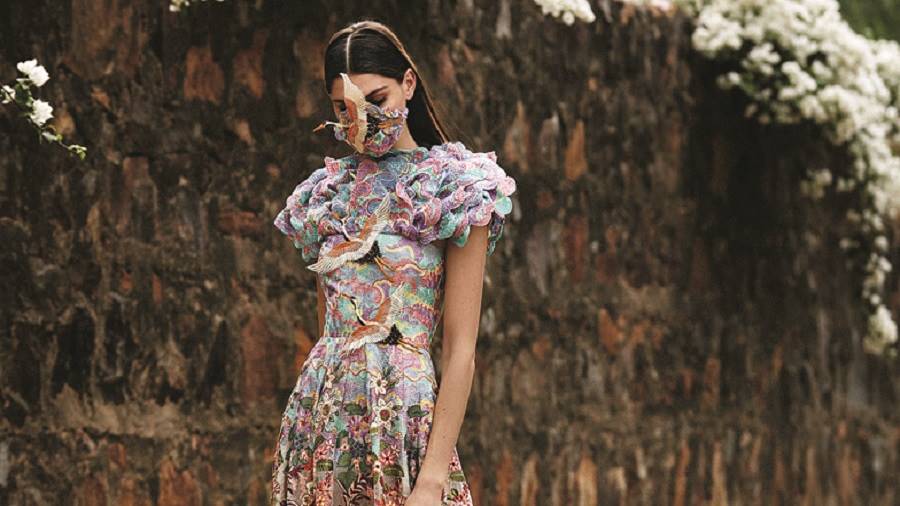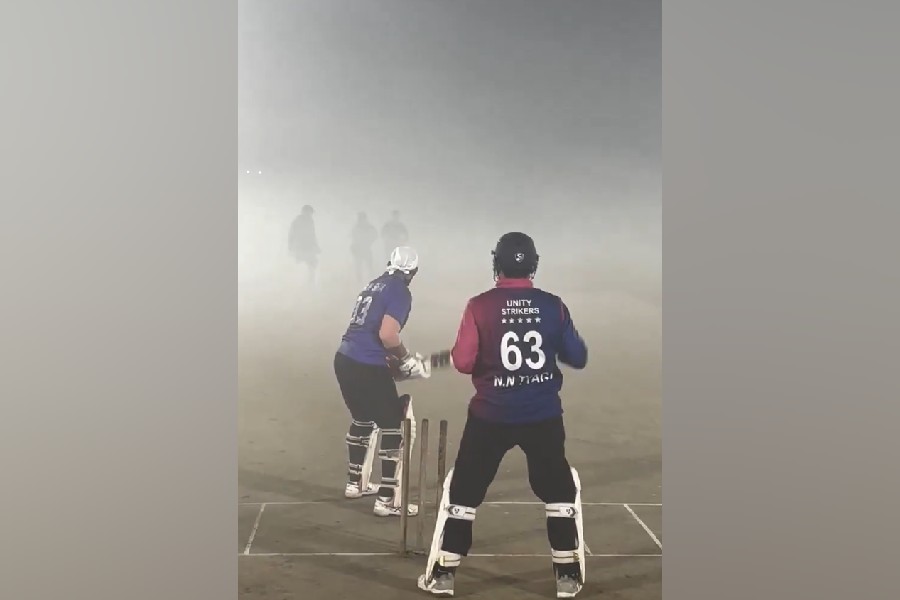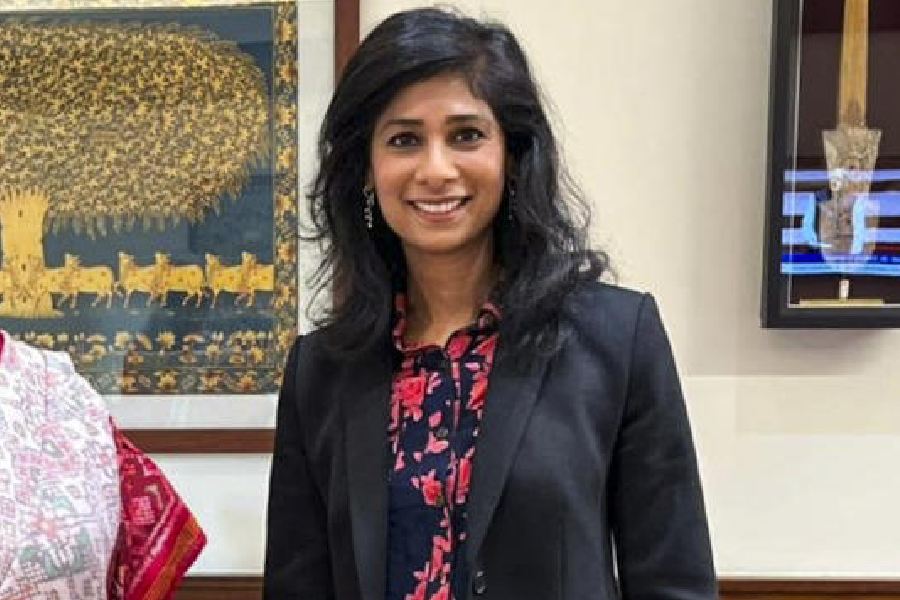There is nothing fancy about Rahul Mishra. “Divya (wife) poochh rahi hai nahana nahin hai kya? That’s the pleasure of working from home,” he shared in the middle of this chat about haute couture and the future of couture. At that very moment, he ceased to be ‘the’ Rahul Mishra, a Paris Fashion Week veteran of 11 seasons or the winner of The International Woolmark Prize (in 2014). Or, when he said that he hadn’t put his four-year-old daughter Aarna to bed during the making of the Haute Couture online show that saw him quarantining to minimise the risk of infection. “‘Papu when you are going to see me?’ she asked me,” he said. And, you felt like reaching out to daddy dearest. You could chat about warp drive with him as much as about warp and weft. As well as the purity of Arundhati Roy as a thought leader akin to the purity of slow fashion. He said he loves Cosmos and Neil deGrasse Tyson and had been reading a lot about Albert Einstein.
As we chatted with Rahul, we got a sneak peek into his working process. He’ll send you images and references of what he was talking about for better engagement. He wouldn’t judge you. Also, the reason why the Delhi-based designer who studied physics followed by design at NID and Istituto Marangoni, Milan, considered acceptance of criticism his biggest strength and his childlike appetite for feedback as his creative fuel. “I don’t want to be like anybody. I am working as an artist,” said Rahul. From that stems fearlessness where only a genuine story matters.
The Telegraph caught up with him after his Haute Couture online show, (with Federation De La Haute Couture Et De La Mode, Paris, that ‘brings together fashion brands that foster creation and international development’) where he showcased his couture fall 2020/21 line — Butterfly People — through a 7.20 minutes video on July 7. “The mail about this event came to me on May 14 after I opened my factory post-lockdown. They had informed us in March that the physical show cannot happen,” said Rahul who debuted at Haute Couture this January, the only Indian designer to do so.
With an 11-year-old global brand under his belt, Rahul said he was enjoying the moment. Of course!
Many congratulations on unveiling a new collection at an international platform in the middle of the pandemic! What kind of feedback have you got so far?
Everything has been very good. It has given me similar or more impact than organising a physical show in Paris.
Were you nervous?
Yeah, yeah... (on the show day) I was nervous. I was nervous about the communication because it was looking less fashion and more documentary type. This was the first time I was shooting my collection and making a film. Half the film was shot by me. I shot the making for a month. I started end of May when the embroiderers came in and I shot it every two-three days in bits and pieces. So, the first part of the collection was shot by me and the fashion bits were shot by Hormis (Antony Tharakan). He edited it too and respected my photography as well! I was thinking, mera toh amateurwala photography.
We shot in this beautiful studio in Delhi next to a farm area and wanted to finish the shoot with models in one day due to social distancing norms. Hormis kept saying it’s good karma. During the evening, it got breezy. The clouds we shot were moving beautifully. There was the blooming bougainvillea. And though it looked it might rain at any point of time, God postponed the rain too! It was as if it was nature’s design.
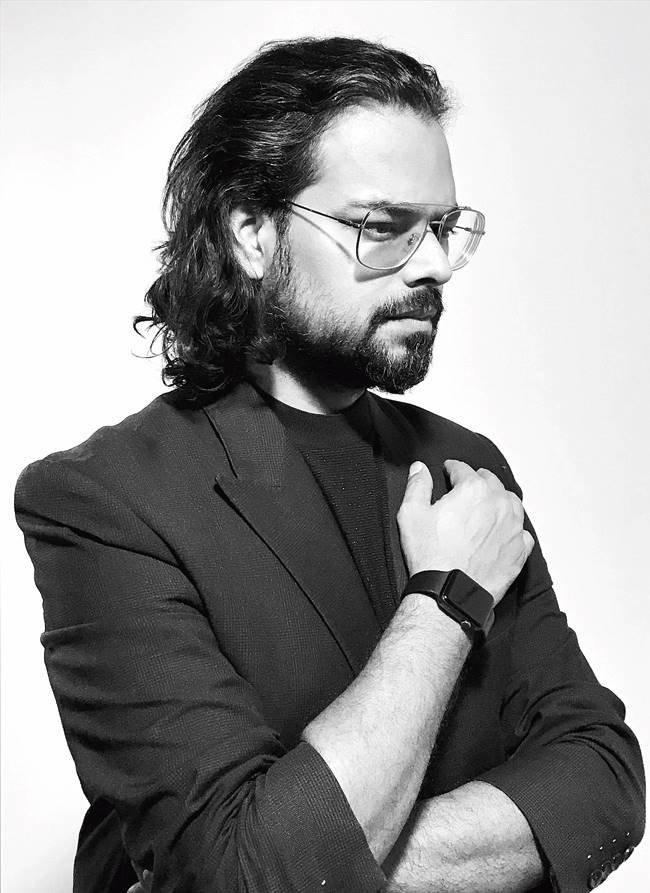
Rahul Mishra Courtesy: Rahul Mishra
We are all at the mercy of nature now...
If we look at the pandemic, where nature has put a halt, businesswise and personally too, but this halt is there because the way we were consuming things from nature had been cacophony. It was not in rhythm and harmony. This a smaller blow compared to what scientists are predicting global warming to be like. This is a temporary situation. This has made us realise that we cannot fight nature. It’s better if we find rhythm. Extinction and rebirth are part of nature’s cycle. Progress has been stepping away from nature. We forget billions of other species with whom we share this planet. Who has given us the permission to do what we have done with animals?! So, nature has whispered a warning. So, for me, this is a positive break that nature has given us.
And nature is a strong backstory in the narrative of your collection…
Richard Powers in The Overstory wrote “The best and easiest way to get a forest to return to any plot of cleared land is to do nothing — nothing at all, and do it for less time than you might think.” So, after a long time, there was a clear blue sky in Delhi and the animals returned to their normal habitat. It really struck me how powerful nature is. It balances out everything. All these inspired me for the collection.
How many pieces are there in the collection?
There are 13 pieces. Usually, I make around 40 pieces in a collection. For Haute Couture, we do around 25-30 pieces which are high-end. The collection was put together over six weeks. This was a very different collection jaise hum bana rahein the. We didn’t have the tools ke samne fat se sketch kar do. We were working on WhatsApp group. So my screen time would be such that you would feel main toh wella baitha hoon, life mein. The productivity graph would be so low! More than 100-odd people worked on this. Conceptualisation took three months. Our factory opened mid-May. We usually get six months for execution.
You also struggled to find some answers…
I was sure I wanted to do this. This is truly global. We wanted to look at positivity as this collection gave us so much more hope. We have to take risks and they can only be taken when you are thinking positive. On our social media, we didn’t speak about clothes at all during the lockdown because we felt this was luxury and there so many people struggling.
Then I realised may be this genuine couture is the only way for people to come out of this struggle. So, these pieces of clothes became way more purposeful for me than what I was doing in the past. I did not find these answers easy. It was a couple of months of mental struggle as to why this world needs another beautiful outfit. It’s not about creating beauty alone or another amazing outfit. This was somehow about the backstory. The outfit exists because it employs and provides livelihood to 10 families. It allows them to dream about building their houses. It allows them to send their kids to school. It was a very big call because social media can troll so much. I had to find a genuine voice from my soul. If a craftsman has to dig roads, that will be the biggest disservice. Everyone has to do the best and do what you do best, which is create slow fashion. I realised long back that when going gets tough, you work on your strengths. And, my strength is slow fashion. Saste kapre nahin banane hai. There is a lot more to be done for craftsmen and I think this storm is going to be longer for craftsmen. I am not saying buy a Rs 2 lakh Rahul Mishra garment, but still go buy a Rs 2,000 handloom sari. This is the time when people need to buy things not produced by factories, but humans.
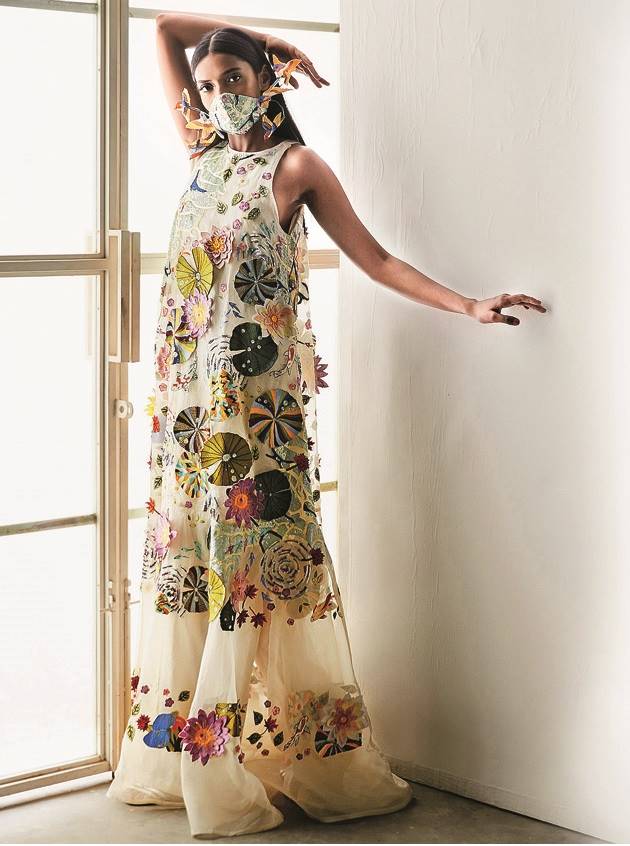
Pieces from Butterfly People — the collection Rahul showcased at Paris Haute Couture online Pictures: Hormis Antony Tharakan (@hormisantonytharakan on Instagram) Make-up: Gursevak Singh (@gurumakeupart on Instagram)
And, you named the collection after them…
“Just living is not enough, said the butterfly, one must have sunshine, freedom and a little flower” — adapted from Hans Christian Andersen, it is really important for me because of the migrant crisis and all that is happening around us.
We supported everybody during the lockdown. Then when the factory opened, I asked them jokingly ke: ‘Bare khush hoge, bina kaam ke paise mil rahe hai!’ I joke with everyone. I connect with everybody when it comes to their aspirations. Their reaction was very surprising. They said they were bugged. ‘Hum yahaan kisi tarike se aana chahte the’ they said. I realised that may be living, earning and supporting is not enough. When a weaver sees a motif, he gets so happy. That is indescribable.
During the lockdown, whenever I have gone to the office a couple of times, the roads in the industrial areas appeared far more wider. I was trying to visualise when people go to work, they are like butterflies. They come in a huddle, in clothes of different colours. And, they are so lively. I also started doing butterflies for the collection because they are victims of corrosive pollution. They are so endangered that you might get to see butterflies one season and you might not the next.
This time we saw lot of birds and butterflies. I wanted to talk about that. Why are there so many butterflies? Because of less human interference.
When I reached my office to execute the collection, I felt like a gardener who is growing these flowers on a piece of fabric and inviting butterflies to come. These people (craftsmen) are like butterflies who are then making my garden more beautiful. Butterflies get nectar, vitality, living out of the flowers and a gardener gets beauty. This thought gave birth to the name Butterfly People. I have been inspired by various things in the past like the earth and rainforest. For this collection, I was inspired by the people. This collection is ‘for butterfly people’, ‘of butterfly people’ and ‘by butterfly people’.
What did you like about the format?
I like the format because you are otherwise judging the outfit with an eight-10 second viewing on the runway. When you are looking at a fashion show, you are looking at the tip of an iceberg. You are only focussing on ‘what’ is there in front of you, which is 10 per cent. You forget about ‘how’, which is the process, about 40 per cent, and ‘why’ it is being created, which is 50 per cent. This time, it was full of heart.
Didn’t you miss the buzz?
I missed the human interaction, getting feedback right then and there, the kind of energy and personality that a model brings to the clothes, the set-up and the craziness of backstage. It has its own beauty, vividness and craziness, emotional high.
You were saying you want to mortgage your house…
When I look at the scenario, businesswise everybody is struggling. Right now, yes, I am looking at mortgaging my house so that I can get more finances. Normally, businesses are designed to last two-three months of no sale, but we have achieved our targets, which is great news for us.
Isn’t that a risk with a young daughter?
Everything exists because of the business. It’s fine. Entrepreneurs are risk-takers. And, there is no risk. We have got such a beautiful brand. The house also exists because of this brand, na?
Not many people think like you…
Main ek baat bataa raha hoon aapko. In a normal business, what happens is I have orders and I am working. Orders nahin hai, toh I am not working. This is a chicken-and-egg situation. I would like to give a message to the entrepreneurs that start working so that you have orders. Do not wait for orders. You can wait and get more embroiderers, but those people might not have waiting time. I am so happy I did this.
My this month’s sale has been amazing. I launched e-commerce with the show (@www.rahulmishra.in). The entire collection is available for sale. We also booked some orders. I had bigger plans for the business. So may be for sustenance, I might have to mortgage the property for finances. I need to grow my business even in these difficult times. Grow meaning involve more people.
Till June 2021, I have promised myself that I won’t have any lay-offs. Looks like this pandemic will stay with us for long. We are a family. Even without zero revenue, Divya and I have calculated that we would be able to support everyone. I did these calculations in April-May when we didn’t know how long the lockdown would last. Beyond that I don’t I know.
Ek aur baat hai, very honestly, nahin kuch hoga toh jaake pada lenge college mein (laughs). If not that, I’ll do organic farming. If you do everything for the kids, you don’t leave them with anything to do in life. When was future certain anyway? In business, I prepare for the worst.
What is your approach to e-commerce now?
We have the direct-to-consumer approach now. We are being able to offer much better pricing than we did ever before. I didn’t do global e-commerce before this because I was doing ready-to-wear, which is bought by a number of retailers and their price points would never match our Indian price points. Now since I am doing haute couture, I could take this chance. This is a risk, but risk comes with confidence. I felt the brand was ready to take on this game of global e-commerce where the brand has enough goodwill.
I have invested very heavily in the last six years in Paris to build a brand, not only in terms of selling but knowledge, respect. People should know us all over the world.

4. Fall/Winter’17 5. Fall/Winter ’18 6. Fall/Winter ’19 Paris Fashion Week pictures: Rahul Mishra
Paris, Je T’aime
Rahul Mishra celebrated with The Telegraph the sixth anniversary of an email he got one July 15, six years ago, around the same time when we called him this July 15! Time: 9.45pm. The email that changed his life. Forever. He described his big ticket to his first Paris Fashion Week in 2014 as “lottery”, the enormity of it hitting him as he stood at Palais de Tokyo that October, an unlikely overwhelmed Divya by his side. The Delhi-based designer has showed at 11 seasons of Paris Fashion Week and two seasons of Haute Couture over these six years. Rahul takes us through the timeline.

4. Fall/Winter’17 5. Fall/Winter ’18 6. Fall/Winter ’19 Paris Fashion Week pictures: Rahul Mishra
The backstory
Didier Grumbach (former president, Federation De La Haute Couture Et De La Mode) came to see a show at FDCI’s Wills Lifestyle India Fashion Week, 2009. It was my debut show and the first day of fashion week. I had done an organic khadi collection. He came to my stall after the show. I explained how it is woven. He loved it and complemented that it is very couture. I received an email from him after a few days later that he was really impressed with my show and asked me to get in touch if I was thinking about Paris Fashion Week at any point. I knew I wasn’t ready and that I had to find my footing in India. 2009 was also the beginning of my company.
Then the Woolmark Prize happened. I won the regional prize in 2013 and in 2014, the International Woolmark Prize. With the confidence of selling collections everywhere, in 2014, in the month of May and June, I happened to travel to Paris for the first time in my life. I wrote to Didier Grumbach informing him that I had won the prize and if I could meet him. He replied after two days. I had to go through a jury he said. On July 15, I received an email saying that my candidature had been accepted. The show was in October (spring/summer’ 15). I started working on some ideas but I must admit, it was more like elaborating on the Woolmark collection.
First time at Paris Fashion Week
On the morning of the show, we entered the hall. We were showcasing at Palais de Tokyo. Everything was happening for the first time. Suddenly you land at Paris Fashion Week at this amazing historical location where 50 people are working just for you. Your name is written beside an Hermes or Miu Miu in a similar font. It struck me then that this was really big! I showed The Ferryman’s Tale. I was from India, getting stories of Indian craftsmen kai saare samundar paar kar ke, like a ferryman, to this new world. The first time is always special.
2015 (Fall/Winter)
I experimented a lot with merino wool for My Village which took inspiration from my village. I took embroidery to the next level in terms of interpretation.
2016 (Spring /Summer)
It was again a next step for me. I started experimenting with 3D embroidery. It was called Fourth Dimension. It was labour of love, handmade.
2016 (Fall/Winter)
With It Felt Love!, I took bandhni to Paris and used patterns that emerge from the beauty of porcelain.
2017 (Spring/ Summer)
Then Elisa Nalin, the stylist, came on board to work with me. So, I started experimenting with layering. The 3D got a different feel. This made me think about fashion in a new kind of language. Henri Rousseau’s jungle was an inspiration for The Rainforest. The clothes got a bit girlie and styling came into it.
2017 (Fall/Winter)
I started experimenting a lot more with colour. I started doing Van Gogh kind of sunflower motifs. Paul Signac was also an inspiration for this Pointillism-inspired collection called Infinity that celebrated the boundlessness of human hands. It allowed me do French knots my way, things which are a lot more dimensional, playing with threads almost in a similar way in which a painter uses his brush. It allowed me to think like an artist.
2018 (Spring/ Summer)
There is a theory which says there was no colour on the planet in the beginning and light got all the colours, which honeybees see. They ride the wavelength of light, which is like a highway for them. So, this was the first time I experimented with so much colour for Light in the Sky.
2018 (Fall /Winter)
I did some strong graphics for Rhizome. Whatever memories of travel I had, I tried to weave it in the collections. Some things are colourful and some are colourless. CG Jung’s rhizome was an inspiration. This was my first brush with sequins.
2019 (Spring /Summer)
I played with new kinds of silhouettes for Gossamer. White-on-whites. Chikankari. I played with a craft called daraz. It is a technique where two layers of fabrics are sewn together and then they are cut out. I also did a lot of textiles for that season.
2019 (Fall /Winter)
For Village Diary, I used all hand-woven textiles. There was Maheshwari and wool blends. It was inspired by my childhood in my village of Malhausi (in Uttar Pradesh).
I applied for Haute Couture too this year, but I needed to do something out of the calendar. I did an entire set-up of putting all the embroideries together. It was showing them a new kind of 3D embroidery. My first Haute Couture participation was not a part of the calendar. This was in July. There were 20 garments in Metropolis 1 (Fall 2019/20 Couture). It involved 3,400 human hours of hand-cutting and hand-embroidering. This was about interpreting cities.
2020 (Spring /Summer)
The Metropolis 2 show had similar pieces like Metropolis 1, an extension, but there were also black-and-white pieces. I took my 3D to the next level even in ready-to-wear, a body of work deserving of haute couture.
The Haute Couture debut
The jury again happened, which was far more stricter, for Haute Couture, which was this January. I am a guest member. As a guest member you need to perform really well. You are always on your toes!
A month later I got an email confirming my Haute Couture show, marking another beginning. I redefined how I was making clothes and how I wanted to do 3D. It was supposed to be more expressive and more experimental. You have to go five notches above what you have been thinking. It was called Home and it gave me the license to go all out. Everybody said this is the new language of haute couture. It doesn’t need to be a showpiece. For me, it takes inspiration from today’s women... how they are more powerful than ever before.
I did an exhibit in ready-to-wear in March called Home 2. I came back in the beginning of March, quarantined and by March 22, everything was under lockdown. This collection had simpler pieces, softer, cleaner, neater.

